Spatiotemporal Evolution of Urban Driving Factors and Seasonal Heat Island Response from the Perspective of Local Climate Zones: A Case Study of Xiamen City, China
Abstract
1. Introduction
2. Materials and Methods
2.1. Study Area
2.2. Data Sources
2.3. Research Methods and Process
2.3.1. Urban Built-Up Area Extraction and Expansion Indicators
2.3.2. Standard Deviation Ellipse Analysis
2.3.3. SUHII Calculation and Temperature Normalization
2.3.4. GeoDetector Model
2.3.5. LCZ Mapping
3. Results
3.1. Analysis of Urban Spatial Expansion Characteristics
3.2. Analysis of SUHI Influencing Factors
3.3. Analysis of Influencing Factors of SUHI
LCZ Mapping Analysis for XIAMEN in 2010 and 2020
3.4. Analysis of SUHI Influencing Factors Based on LCZ
4. Discussion
4.1. Attribution of Urban Spatial Expansion
4.2. Discussion on the Main Factors Affecting SUHI
- (1)
- Prioritize implementing green roofs and vertical vegetation systems for LCZ 5 in summer to reduce surface and environmental temperatures. Use reflective and high reflectivity materials on the exterior walls and road surfaces of buildings. In the winter, introduce vegetation buffer zones and wind corridors in LCZ 8 to promote heat dissipation.
- (2)
- Use porous materials as the new generation of environmentally friendly pavement materials and increase roadside greenery. In addition, protect existing water bodies and integrate them into a broader urban cooling network. Additionally, ensure hydrological connectivity between water bodies and green infrastructure to amplify cooling effects.
- (3)
- Finally, incorporate LCZ classification into the urban planning process to better monitor more refined urban heat island.
5. Conclusions
- (1)
- Urban expansion: From 2003 to 2020, the built-up area significantly increased in the northwest and northeast directions. The proportion of the tertiary industry increased with the decrease of the proportion of the secondary industry, mainly concentrated in the Jimei District. The spatial distribution of GDP development was increasingly concentrated in the Huli District and Siming District.
- (2)
- Non-linear SUHI expansion: The SUHI effect shows non-linear growth with urbanization, consistent with the expansion and development direction of built-up areas. The explanatory power of various influencing factors on SUHII in Xiamen was ranked as follows: population density (x1) > built-up areas (x2) > per capita GDP (x7) > building height (x4) > secondary industry proportion (x5) > sky openness (x3) > tertiary industry proportion (x6). Population density was identified as the most significant factor influencing SUHI, with q-values of 0.626 in the summer and 0.574 in the winter. The interactions between factors were also found to significantly shape the spatial heterogeneity of the SUHI effect, with the highest explanatory combinations reflecting strong interactions.
- (3)
- Based on LCZ type analysis: The relationship between the SUHI effect and urban characteristic variables showed significant seasonality and spatial heterogeneity. Positive correlations between population density (x1), built-up areas (x2), sky view factor (x3), and GDP per capita (x7) with the SUHI effect were particularly pronounced in both the summer and winter, especially in built-up LCZs. Conversely, the proportion of the tertiary industry (x6) exhibited an inhibitory effect on the SUHI effect in both the summer and winter. Building height (x4) and the secondary industry proportion (x5) intensified the SUHI effect in the summer, with dynamic changes observed during the winter.
Author Contributions
Funding
Data Availability Statement
Conflicts of Interest
References
- Rahman, M.N.; Rony, M.R.H.; Jannat, F.A.; Chandra Pal, S.; Islam, M.S.; Alam, E.; Islam, A.R.M.T. Impact of Urbanization on Urban Heat Island Intensity in Major Districts of Bangladesh Using Remote Sensing and Geo-Spatial Tools. Climate 2022, 10, 3. [Google Scholar] [CrossRef]
- Ren, Y.; Raffaele, L.; Vincenzo, G.; Giovanni, S.; Zhang, X.; Chengyang, X. The unrelenting global expansion of the urban heat island over the last century. Sci. Total Environ. 2023, 880, 163276. [Google Scholar] [CrossRef] [PubMed]
- Susca, T.; Pomponi, F. Heat island effects in urban life cycle assessment: Novel insights to include the effects of the urban heat island and UHI-mitigation measures in LCA for effective policy making. J. Ind. Ecol. 2020, 24, 410–423. [Google Scholar] [CrossRef]
- Zhao, S.; Zhou, D.; Liu, S. Data concurrency is required for estimating urban heat island intensity. Environ. Pollut. 2016, 208 Pt A, 118–124. [Google Scholar] [CrossRef]
- Yao, Y.; Chen, X.; Qian, J. Research progress on the thermal environment of the urban surfaces. Acta Ecol. Sin. 2018, 38, 1134–1147. [Google Scholar] [CrossRef]
- Meng, Q.; Zhang, L.; Sun, Z.; Meng, F.; Wang, L.; Sun, Y. Characterizing spatial and temporal trends of surface urban heat island effect in an urban main built-up areas: A 12-year case study in Beijing, China. Remote Sens. Environ. 2018, 204, 826–837. [Google Scholar] [CrossRef]
- Yang, J.; Ren, J.; Sun, D.; Xiao, X.; Xia, J.; Jin, C.; Li, X. Understanding land surface temperature impact factors based on local climate zones. Sustain. Cities Soc. 2021, 69, 826–837. [Google Scholar] [CrossRef]
- Zhu, R.; Zhao, N.; Wang, Q.; Meng, C.; Liu, M.; Li, G. Research on the influence of urban heat island (UHI) intensity on energy consumption for heating and cooling of existing residential buildings in different climate zones. South Archit. 2020, 5, 16–20. [Google Scholar] [CrossRef]
- He, B.-J.; Wei, W.; Ayyoob, S.; Liu, X. Progress, knowledge gap and future directions of urban heat mitigation and adaptation research through a bibliometric review of history and evolution. Energy Build. 2023, 287, 112976. [Google Scholar] [CrossRef]
- Han, S.; Tang, Q.; Xu, D.; Yang, Z. Impacts of urbanization and agricultural development on observed changes in surface air temperature over mainland China from 1961 to 2005. Theor. Appl. Climatol. 2019, 135, 1595–1607. [Google Scholar] [CrossRef]
- Lin, D.; Xie, Y.; Ou, L.; Cao, D. Study on urban heat island effect in Loudi city, Hunan Province. Build. Sci. 2020, 36, 84–88. [Google Scholar] [CrossRef]
- Yang, Z.; Chen, Y.; Qian, Q.; Wu, Z.; Zheng, Z.; Huang, Q. The coupling relationship between construction land expansion and high-temperature areas expansion in China’s three major urban agglomerations. Int. J. Remote Sens. 2019, 40, 6680–6699. [Google Scholar] [CrossRef]
- Qiu, G.; Zhang, X. China’s urbanization and its ecological environment challenges in the 21st century. Adv. Earth Sci. 2019, 34, 640–649. [Google Scholar] [CrossRef]
- Pan, Y.; Cui, L.; Liu, C.; Chen, L.; Zhang, L. Spatio-temporal analysis of urban heat island effect in Chongqing based on MODIS data. Chin. J. Ecol. 2018, 37, 3736–3745. [Google Scholar] [CrossRef]
- Han, X.; Yu, J.; Shi, L.; Zhao, X.; Wang, J. Spatiotemporal evolution of ecosystem service values in an areas dominated by vegetation restoration: Quantification and mechanisms. Ecol. Ind. 2021, 131, 108191. [Google Scholar] [CrossRef]
- Peng, J.; Cheng, X.; Hu, Y.; Corcoran, J. A landscape connectivity approach to mitigating the urban heat island effect. Landsc. Ecol. 2022, 37, 1707–1719. [Google Scholar] [CrossRef]
- Liu, Y.; Mu, K.; Han, B.; Zhang, M.; Bao, J.; Yang, Y. Surface urban heat island effect of local climate zone. J. Harbin Inst. Technol. 2021, 53, 192–200. [Google Scholar] [CrossRef]
- Liu, T.; Qi, Y.; Cao, G.; Liu, H. Spatial patterns, driving forces, and urbanization effects of China’s internal migration: County-level analysis based on the 2000 and 2010 censuse. J. Geogr. Sci. 2015, 25, 236–256. [Google Scholar] [CrossRef]
- Yang, X.; Yao, L.; Jin, T.; Jiang, Z.; Peng, L.; Ye, Y. Temporal and spatial variations of local temperatures in the summer of Nanjing. J. Civ. Environ. Eng. 2019, 41, 160–167. [Google Scholar] [CrossRef]
- Moffett, B.K.; Makido, Y.; Shandas, V. Urban-Rural Surface Temperature Deviation and Intra-Urban Variations Contained by an Urban Growth Boundary. Remote Sens. 2019, 11, 2683. [Google Scholar] [CrossRef]
- Yang, X.; Yao, L.; Jin, T.; Peng, L.L.; Jiang, Z.; Hu, Z.; Ye, Y. Assessing the thermal behavior of different local climate zones in the Nanjing metropolis, China. Build. Environ. 2018, 137, 171–184. [Google Scholar] [CrossRef]
- Bai, Y.; Wang, K.; Ren, Y.; Li, M.; Ji, R.; Wu, X.; Yan, H.; Lin, T.; Zhang, G.; Zhou, X.; et al. 3D compact form as the key role in the cooling effect of greenspace landscape pattern. Ecol. Indic. 2024, 160, 111776. [Google Scholar] [CrossRef]
- Stewart, I.D.; Oke, T.R. Local Climate Zones for Urban Temperature Studies. Bull. Am. Meteorol. Soc. 2012, 93, 1879–1900. [Google Scholar] [CrossRef]
- Geletič, J.; Lehnert, M. GIS-based delineation of local climate zones: The case of medium-sized Central European cities. Morav. Geogr. Rep. 2016, 24, 2–12. [Google Scholar] [CrossRef]
- Liu, H.; He, B.; Gao, S.; Zhan, Q.; Yang, C. Influence of non-urban reference delineation on trend estimate of surface urban heat island intensity: A comparison of seven methods. Remote Sens. Environ. 2023, 296, 113735. [Google Scholar] [CrossRef]
- Hidalgo, J.; Dumas, G.; Masson, V.; Petit, G.; Bechtel, B.; Bocher, E.; Foley, M.; Schoetter, R.; Mills, G. Comparison between local climate zones maps derived from administrative datasets and satellite observations. Urban Clim. 2019, 27, 64–89. [Google Scholar] [CrossRef]
- Wang, X.; Yang, J.; Yu, W.; Yu, H.; Xiao, X.; Xia, J. Spatial effect of urban morphology on land surface temperature from the perspective of local climate zone. Remote Sens. Appl. Soc. Environ. 2024, 36, 101324. [Google Scholar] [CrossRef]
- Zhang, L.; Nikolopoulou, M.; Guo, S.; Song, D. Impact of LCZs spatial pattern on urban heat island: A case study in Wuhan, China. Build. Environ. 2022, 226, 109785. [Google Scholar] [CrossRef]
- Kotharkar, R.; Bagade, A. Evaluating urban heat island in the critical local climate zones of an Indian city. Landsc. Urban Plan. 2018, 169, 92–104. [Google Scholar] [CrossRef]
- Zhao, Z.; Sharifi, A.; Dong, X.; Shen, L.; He, B.J. Spatial Variability and Temporal Heterogeneity of Surface Urban Heat Island Patterns and the Suitability of Local Climate Zones for Land Surface Temperature Characterization. Remote Sens. 2021, 13, 4338. [Google Scholar] [CrossRef]
- Dimitris, P.; Dimitris, F.; Thomas, B.; Constantinos, N.K. Impact of urban heat island development on buildings’ energy consumption. Fresenius Environ. Bull. 2013, 22, 2087–2092. [Google Scholar]
- Quan, S.J.; Bansal, P. A systematic review of GIS-based local climate zone mapping studies. Build. Environ. 2021, 196, 107791. [Google Scholar] [CrossRef]
- Demuzere, M.; Kittner, J.; Bechtel, B. LCZ Generator: A web application to create Local Climate Zone maps. Front. Environ. Sci. 2021, 9, 637455. [Google Scholar] [CrossRef]
- Bechtel, B.; Alexander, P.J.; Böhner, J.; Ching, J.; Conrad, O.; Feddema, J.; Mills, G.; See, L.; Stewart, I. Mapping local climate zones for a worldwide database of the form and function of cities. ISPRS Int. J. Geo-Inf. 2015, 4, 199–219. [Google Scholar] [CrossRef]
- Zheng, B.; Chen, Y.; Hu, Y. Analysis of land cover and SUHII pattern using local climate zone framework—A case study of Chang-Zhu-Tan main urban area. Urban Clim. 2022, 43, 101153. [Google Scholar] [CrossRef]
- Lin, J.; Qiu, S.; Tan, X.; Zhuang, Y. Measuring the relationship between morphological spatial pattern of green space and urban heat island using machine learning methods. Build. Environ. 2023, 228, 109910. [Google Scholar] [CrossRef]
- Guo, G.; Zhou, X.; Wu, Z.; Xiao, R.; Chen, Y. Characterizing the impact of urban morphology heterogeneity on land surface temperature in Guangzhou, China. Environ. Model. Softw. 2016, 84, 427–439. [Google Scholar] [CrossRef]
- Dai, Z.; Guldmann, J.M.; Hu, Y. Thermal impacts of greenery, water, and impervious structures in Beijing’s Olympic areas: A spatial regression approach. Ecol. Indic. 2019, 97, 77–88. [Google Scholar] [CrossRef]
- Wang, G.; Zhang, Q.; Xiao, R.; Guan, D. On impacts of land use, population density and altitude on the urban heat island. J. Yunnan Univ. Nat. Sci. 2019, 41, 82–90. [Google Scholar] [CrossRef]
- Chang, Y.; Xiao, J.; Li, X.; Zhou, D.; Wu, Y. Combining GOES-R and ECOSTRESS land surface temperature data to investigate diurnal variations of surface urban heat island. Sci. Total Environ. 2022, 823, 153652. [Google Scholar] [CrossRef]
- Cai, M.; Ren, C.; Xu, Y.; Lau, K.; Wang, R. Investigating the relationship between local climate zone and land surface temperature using an improved WUDAPT methodology—A case study of Yangtze River Delta, China. Urban Clim. 2018, 24, 485–502. [Google Scholar] [CrossRef]
- Wang, R.; Cai, M.; Ren, C.; Bechtel, B.; Xu, Y. Detecting multi-temporal land cover change and land surface temperature in Pearl River Delta by adopting local climate zone. Urban Clim. 2019, 28, 100455. [Google Scholar] [CrossRef]
- Zheng, Y.; Ren, C.; Shi, Y.; Yim, S.H.; Lai, D.Y.; Xu, Y.; Fang, C.; Li, W. Mapping the spatial distribution of nocturnal urban heat island based on Local Climate Zone framework. Build. Environ. 2023, 234, 110197. [Google Scholar] [CrossRef]
- Mo, N.; Han, J.; Yin, Y.; Zhang, Y. Seasonal analysis of land surface temperature using local climate zones in peak forest basin topography: A case study of Guilin. Build. Environ. 2024, 247, 111042. [Google Scholar] [CrossRef]
- Zhou, M.; Wang, R.; Guo, Y. How urban spatial characteristics impact surface urban heat island in subtropical high-density cities based on LCZs: A case study of Macau. Sustain. Cities Soc. 2024, 112, 105587. [Google Scholar] [CrossRef]
- Wu, W.B.; Ma, J.; Banzhaf, E.; Meadows, M.E.; Yu, Z.-W.; Guo, F.-X.; Sengupta, D.; Cai, X.-X.; Zhao, B. A first Chinese building height estimate at 10 m resolution (CNBH-10 m) using multi-source earth observations and machine learning. Remote Sens. Environ. 2023, 291, 113578. [Google Scholar] [CrossRef]
- Lu, L.; Weng, Q.; Xiao, D.; Guo, H.; Li, Q.; Hui, H. Spatiotemporal variation of surface urban heat island in relation to land cover composition and configuration: A multi-scale case study of Xi’an, China. Remote Sens. 2020, 12, 2713. [Google Scholar] [CrossRef]
- Wang, Y.; Shen, Z. Comparing Luojia 1-01 and VIIRS nighttime light data in detecting urban spatial structure using a threshold-based kernel density estimation. Remote Sens. 2021, 13, 1574. [Google Scholar] [CrossRef]
- Wang, H.; Hu, Z.; Li, F.; Zhou, Y. Research on the Spatial-Temporal Process of Urbanization in Chengdu-Chongqing Region based on Nighttime Light from 2000 to 2018. Remote Sens. Technol. Appl. 2022, 37, 897–907. [Google Scholar]
- Yan, Y.; Lei, H.; Chen, Y.; Zhou, B. Analyzing the Dynamic Spatiotemporal Changes in Urban Extension across Zhejiang Province Using NPP-VIIRS Nighttime Light Data. Remote Sens. 2022, 14, 3212. [Google Scholar] [CrossRef]
- Qiao, Z.; Huang, N.; Xu, X.; Sun, Z.; Wu, C.; Yang, J. Spatio-temporal pattern and evolution of the urban thermal landscape in metropolitan Beijing between 2003 and 2017. Acta Geogr. Sin. 2019, 74, 475–489. [Google Scholar] [CrossRef]
- Kim, S.W.; Brown, R.D. Urban heat island (UHI) intensity and magnitude estimations: A systematic literature review. Sci. Total Environ. 2021, 779, 146389. [Google Scholar] [CrossRef]
- Lu, Y.; He, T.; Xu, X.; Qiao, Z. Investigation the robustness of standard classification methods for defining urban heat island. IEEE J. Sel. Top. Appl. Earth Obs. Remote Sens. 2021, 14, 11386–11394. [Google Scholar] [CrossRef]
- Wang, J.; Xu, C. Geodetector: Principle and prospective. Acta Geogr. Sin. 2017, 72, 116–134. [Google Scholar] [CrossRef]
- Bechtel, B.; Alexander, P.J.; Beck, C.; Böhner, J.; Brousse, O.; Ching, J.; Demuzere, M.; Fonte, C.; Gál, T.; Hidalgo, J.; et al. Generating WUDAPT level 0 data—Current status of production and evaluation. Urban Clim. 2019, 27, 24–45. [Google Scholar] [CrossRef]
- Zhao, Z. The analyse on urban heat-island effect factors and the countermeasures on the issue. Environ. Monit. China 2008, 24, 77–79. [Google Scholar] [CrossRef]
- Taripanah, F.; Ranjbar, A. Quantitative analysis of spatial distribution of land surface temperature (LST) in relation Ecohydrological, terrain and socio-economic factors based on Landsat data in mountainous areas. Adv. Space Res. 2021, 68, 3622–3640. [Google Scholar] [CrossRef]
- Shen, Z.; Zeng, J. Spatial relationship of heat island intensity to correlated land surface factors in Xiamen City. Sci. Geogr. Sin. 2020, 40, 842–852. [Google Scholar] [CrossRef]
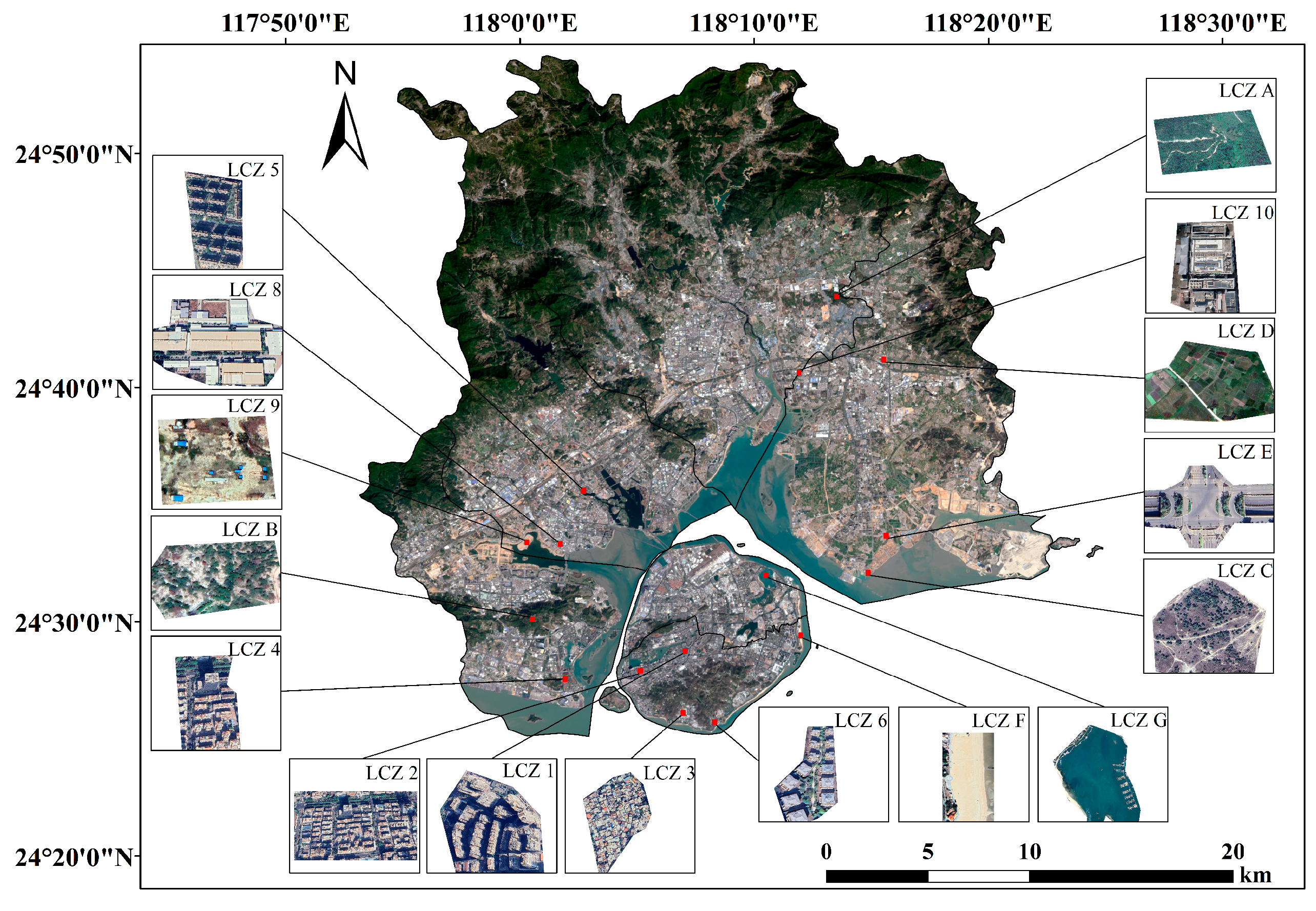
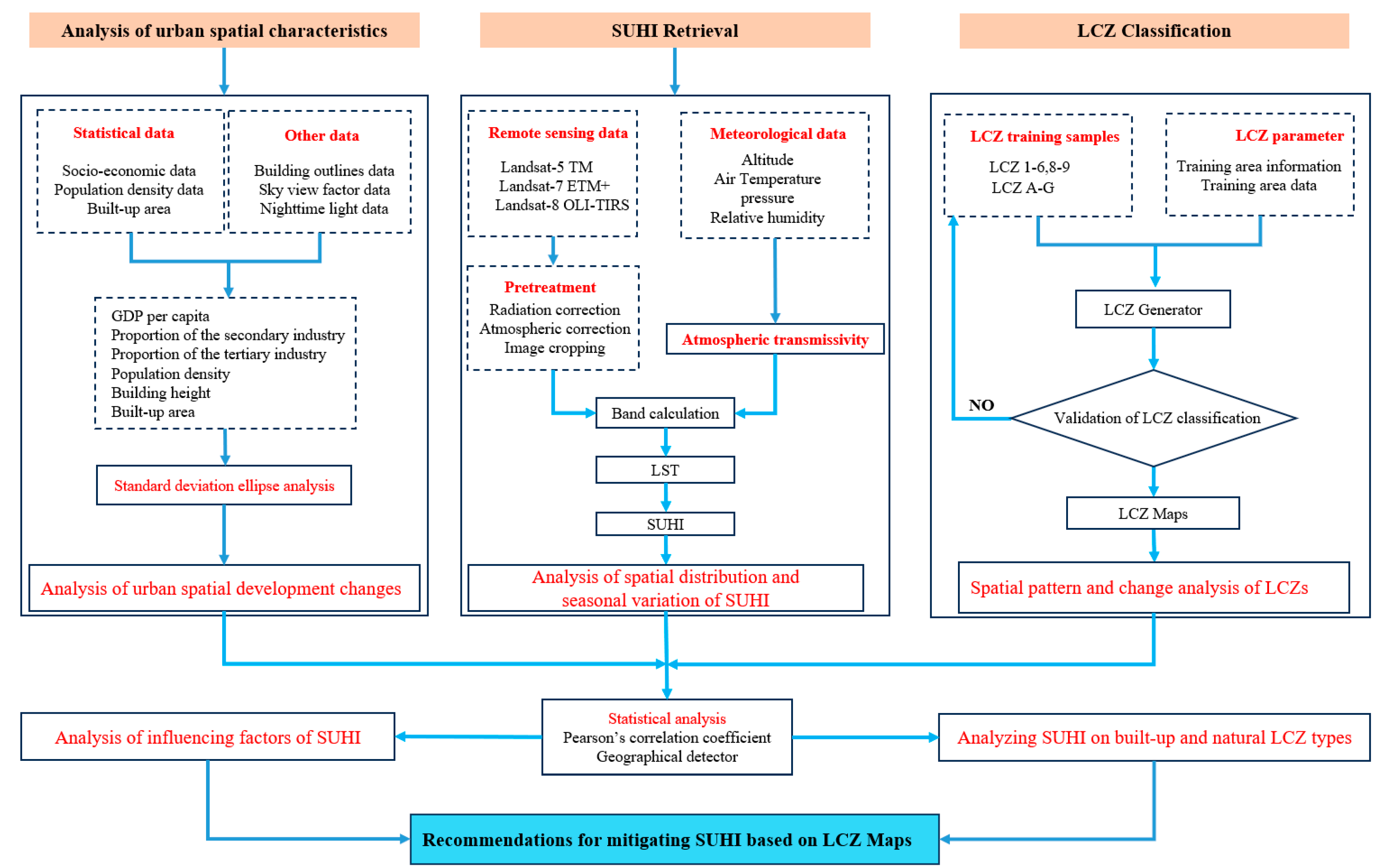
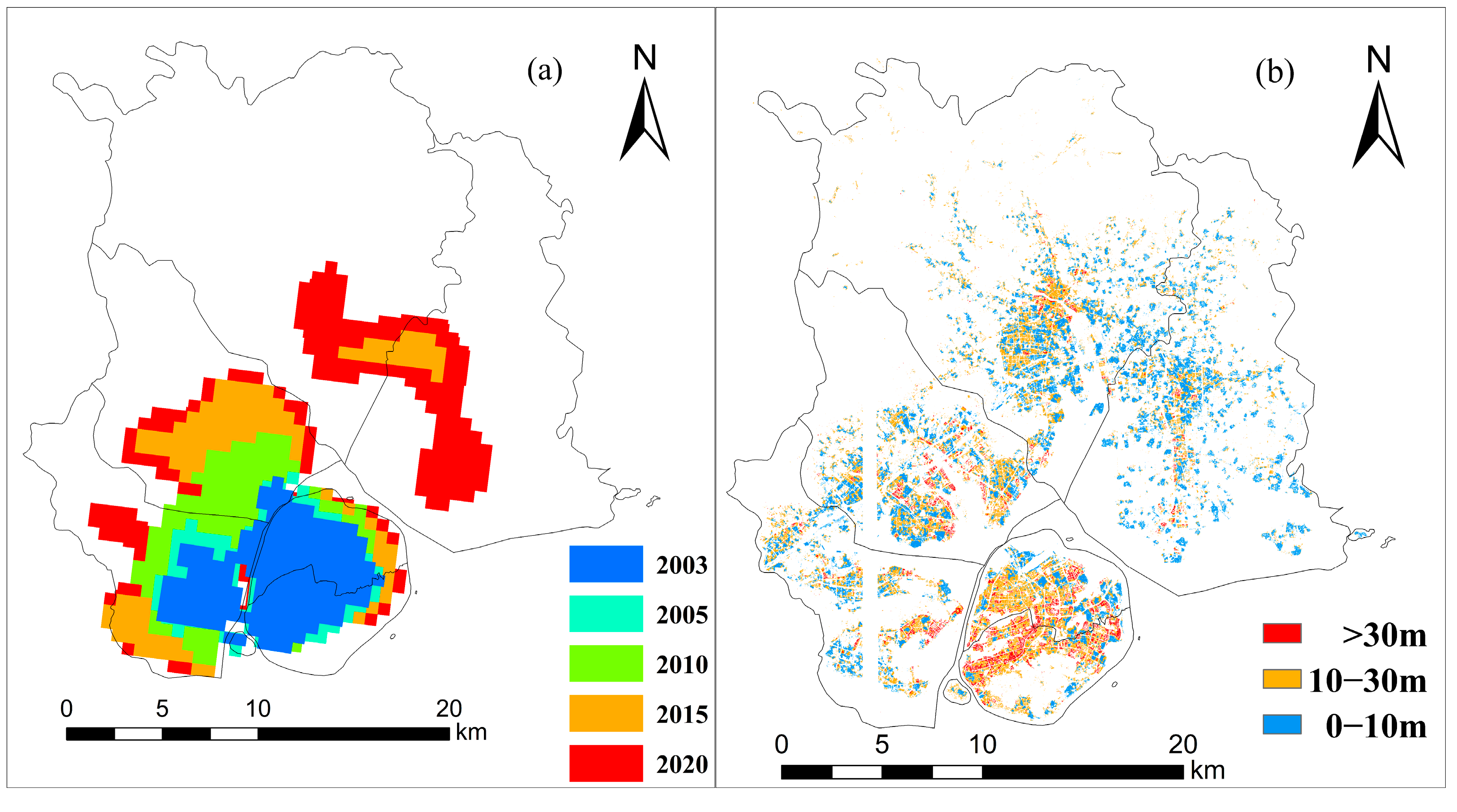
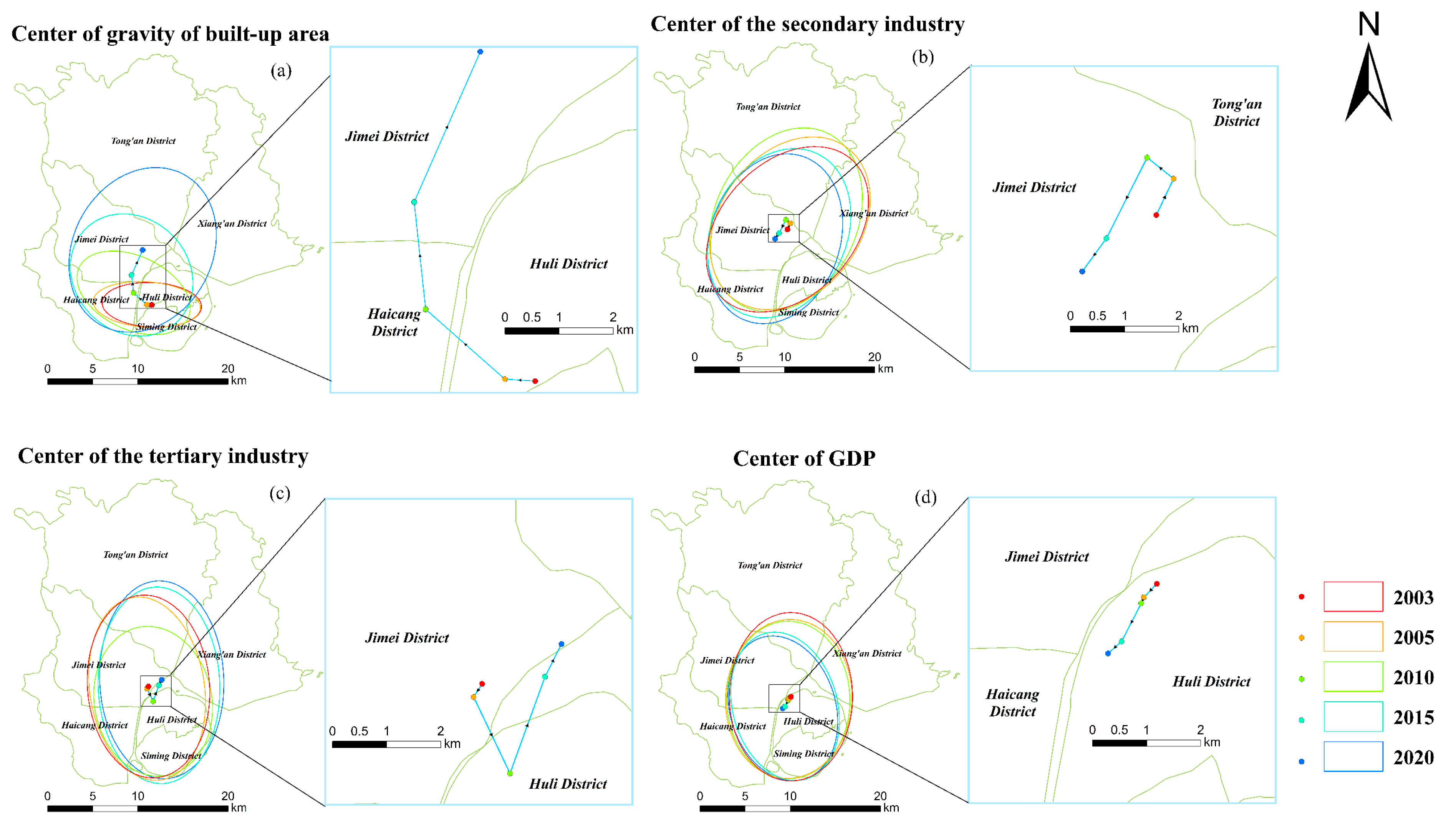
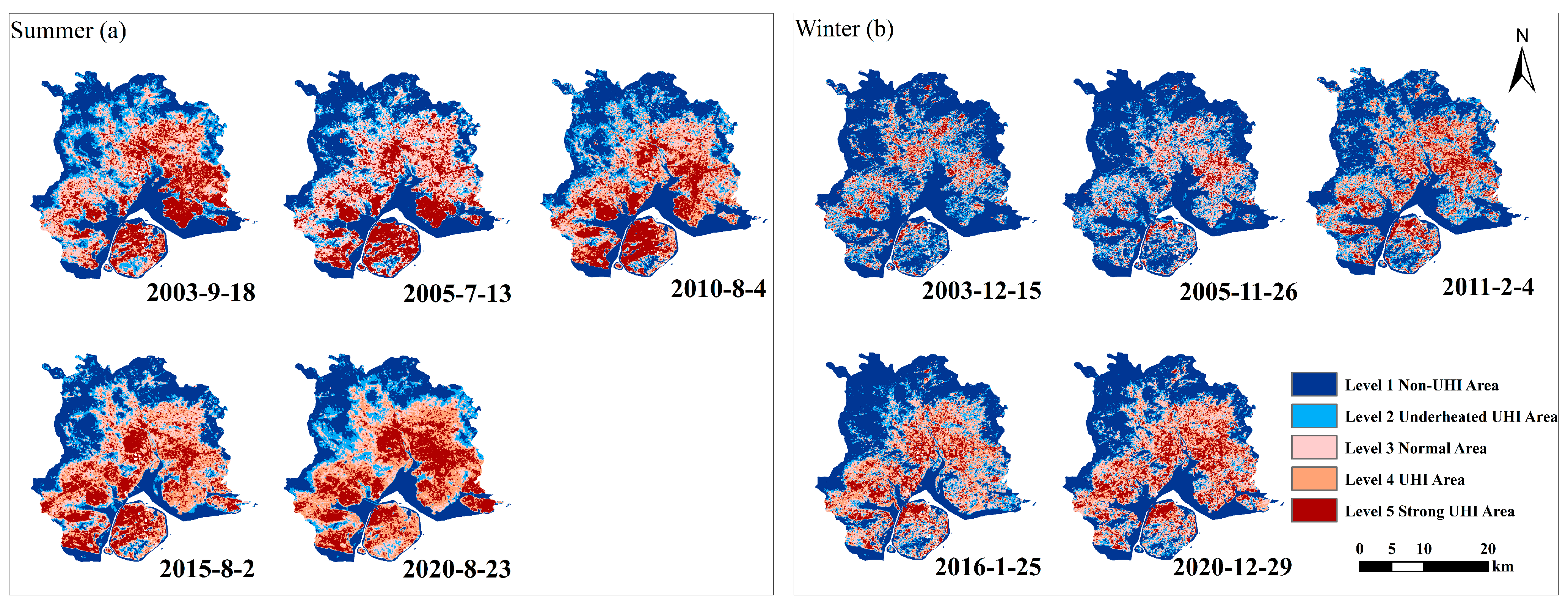
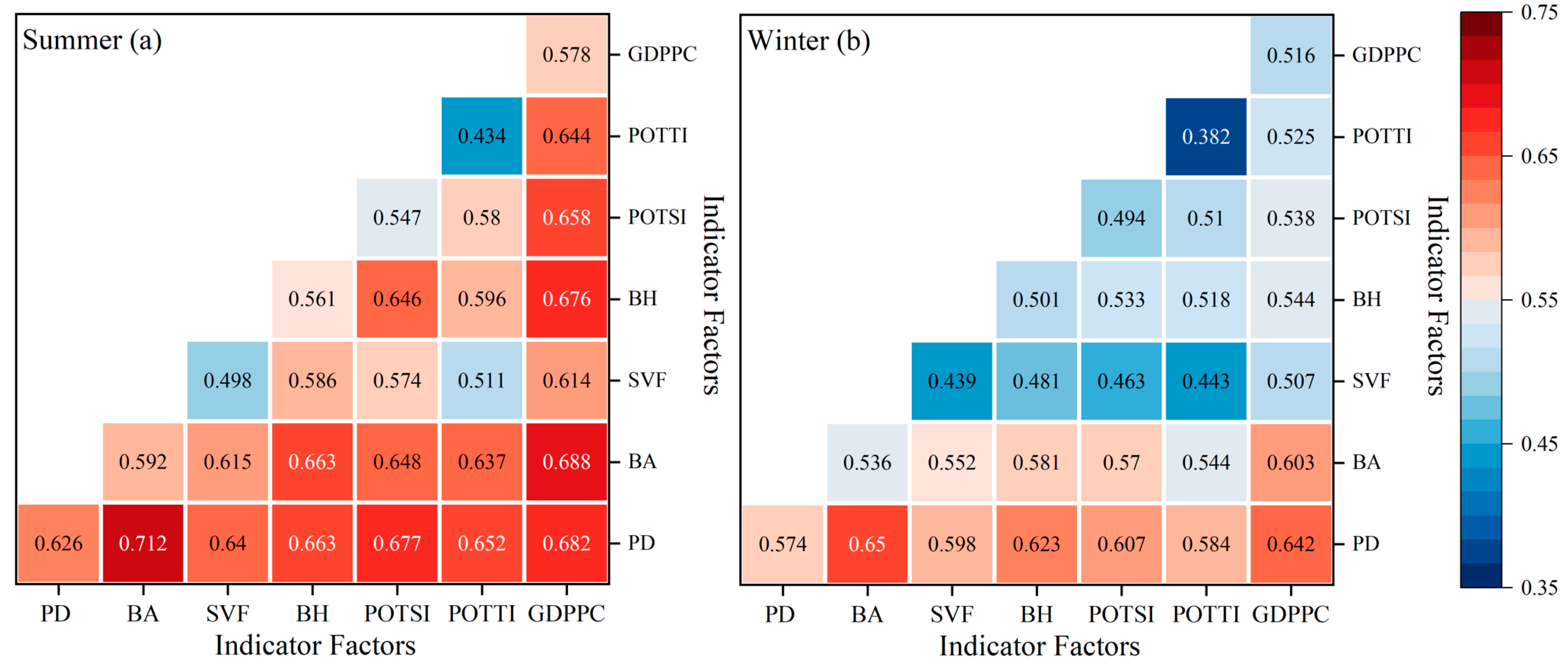
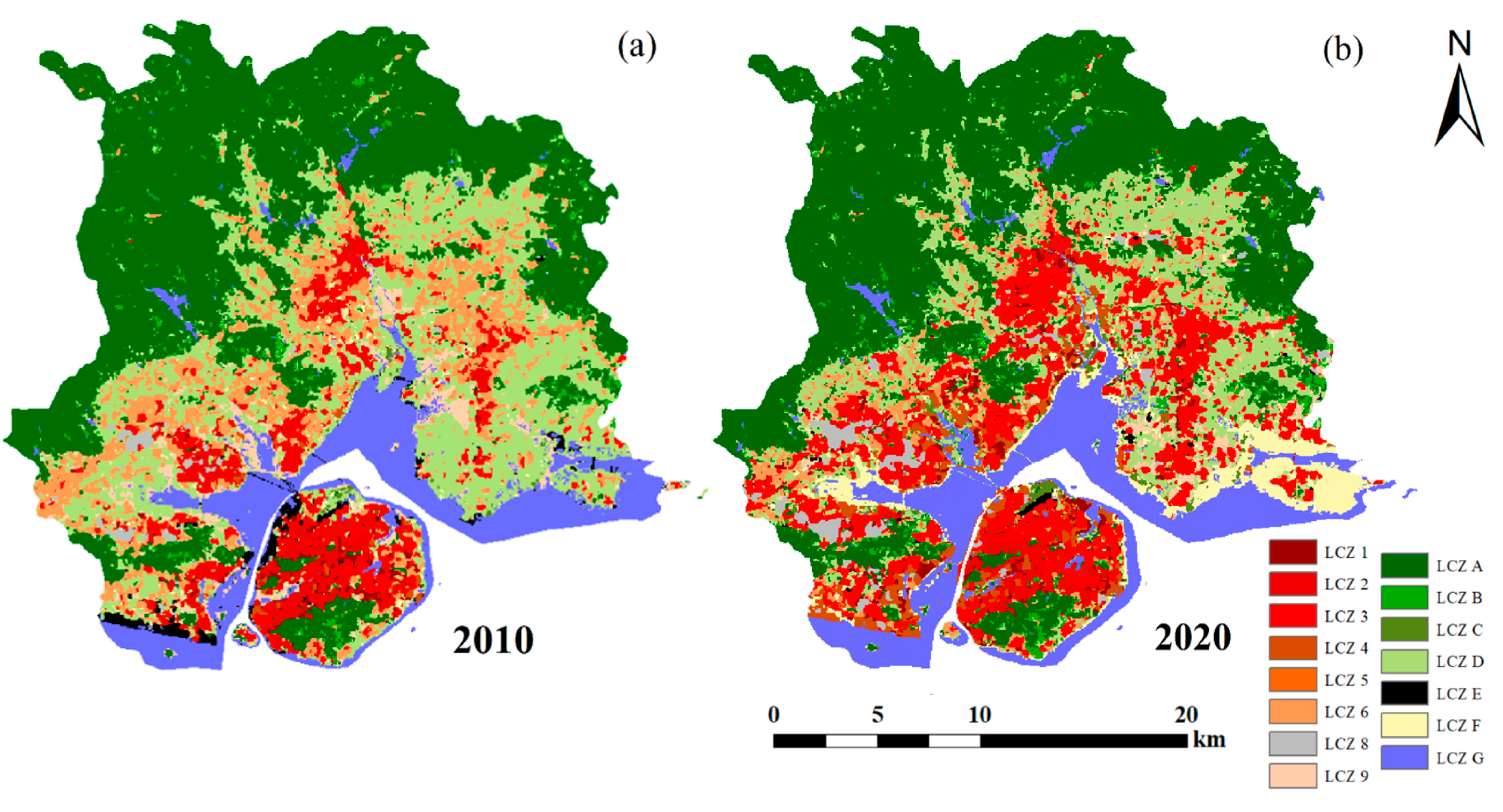
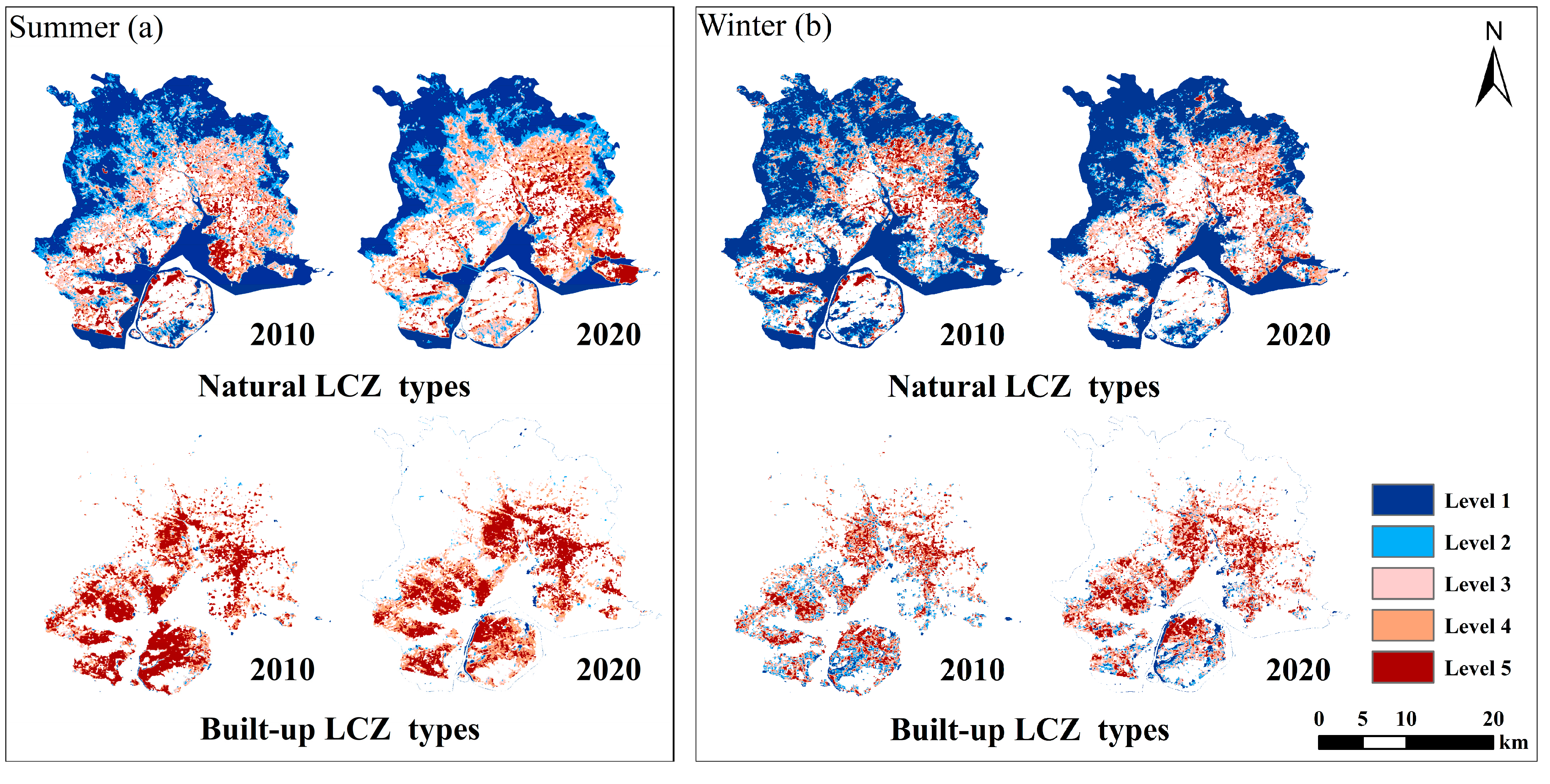


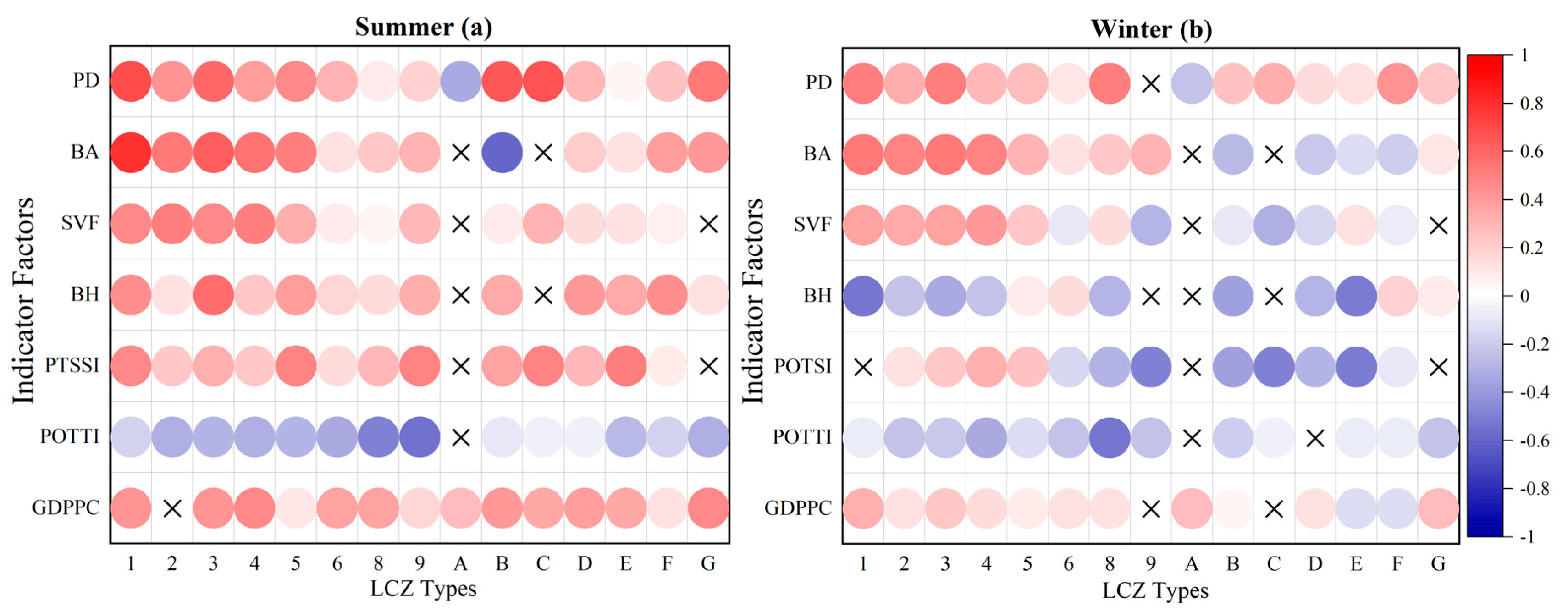
| Date | Time | Spatial Resolution | Source |
|---|---|---|---|
| Landsat-5 TM Landsat-7 ETM+ Landsat-8 OLI-TIRS | 18 September 2003 | 30 m | UGSS |
| 13 July 2005 | |||
| 4 August 2010 | |||
| 2 August 2015 | |||
| 23 August 2020 | |||
| 15 December 2003 | |||
| 26 November 2005 | |||
| 4 February 2011 | |||
| 25 January 2016 | |||
| 29 December 2020 | |||
| Building height | 2020 | 10 m | CNBH-10 m |
| Building outlines | 2020 | - | Amap |
| Nighttime light image | 2003–2020 | 500 m | NOAA |
| Population density | 2003–2020 | 100 m | WorldPop |
| Level of SUHI | Normalized Temperature Value |
|---|---|
| Level 1: Non-SUHI areas | 0.00–0.20 |
| Level 2: Underheated SUHI areas | 0.20–0.40 |
| Level 3: Normal areas | 0.40–0.60 |
| Level 4: SUHI areas | 0.60–0.80 |
| Level 5: Strong SUHI areas | 0.80–1.00 |
| Variable | Abbreviation | Symbol |
|---|---|---|
| Proportion of SUHI effect areas | — | y |
| Population density | PD | x1 |
| Built-up areas | BA | x2 |
| Sky view factor | SVF | x3 |
| Building height | BH | x4 |
| Proportion of the secondary industry | POTSI | x5 |
| Proportion of the tertiary industry | POTTI | x6 |
| GDP per capita | GDPPC | x7 |
| Category | Characteristics | Category | Characteristics |
|---|---|---|---|
| LCZ 1 Compact high-rise | Compact buildings of 10 stories or more, paved surfaces, limited greenspaces and trees. | LCZ A Dense trees | Dense evergreen or deciduous tree forests; permeable surfaces primarily composed of low vegetation. |
| LCZ 2 Compact mid-rise | Compact buildings of 3 to 9 stories, paved surfaces, limited greenspaces and trees. | LCZ B Scattered trees | Sparse evergreen or deciduous tree forests; permeable surfaces primarily composed of low vegetation. |
| LCZ 3 Compact low-rise | Compact buildings of 1 to 3 stories, paved surfaces, Limited greenspaces and trees. | LCZ C Bush scrub | Shrubs or very few trees; permeable surfaces primarily composed of bare soil or sand. |
| LCZ 4 Open high-rise | Low-density, relatively open buildings of 10 stories or more, abundant trees and greenspaces. | LCZ D Low plants | Low vegetation or herbaceous plants; very few trees or no trees. |
| LCZ 5 Open mid-rise | Low-density, relatively open buildings of 3 to 9 stories, abundant trees and greenspaces. | LCZ E Bare rock or paved | Rock or paved surfaces; very few trees or no trees. |
| LCZ 6 Open low-rise | Low-density, relatively open buildings of 1 to 3 stories, abundant trees and greenspaces. | LCZ F Bare soil or sand | Soil or sandy areas; very few trees or no trees. |
| LCZ 8 Large low-rise | Large and open buildings of 1 to 3 stories, paved surfaces, minimal greenspaces and trees. | LCZ G Water | Large waterbodies such as rivers, lakes, and seas; small waterbodies such as ponds and reservoirs. |
| LCZ 9 Sparsely built | Sparse medium-to-small buildings in a natural environment, abundant trees and greenspaces. |
| Time | 2003 | 2005 | 2010 | 2015 | 2020 |
|---|---|---|---|---|---|
| Expansion Characteristic | |||||
| Built-up areas (km2) | 108.52 | 135.21 | 241.64 | 332.14 | 413.99 |
| Growth areas (km2) | — | 26.69 | 106.43 | 90.50 | 81.85 |
| Growth rate (km2/a) | — | 13.34 | 21.29 | 18.10 | 16.37 |
| Growth intensity (%) | — | 12.30 | 15.74 | 7.49 | 4.99 |
| Time | 2003 | 2005 | 2010 | 2015 | 2020 | |
|---|---|---|---|---|---|---|
| Standard Ellipse Deviation | ||||||
| Center of gravity offset distance (km) | — | 0.90 | 3.14 | 3.21 | 4.89 | |
| Built-up areas | Rotation angle (°) | 99.07 | 100.15 | 117.94 | 123.85 | 48.77 |
| Areas (km2) | 110.87 | 121.91 | 220.60 | 371.31 | 597.03 | |
| The secondary | Center of gravity offset distance (km) | — | 1.20 | 1.01 | 2.69 | 1.22 |
| industry | Rotation angle (°) | 34.60 | 57.60 | 53.18 | 42.04 | 43.10 |
| Areas (km2) | 612.34 | 556.74 | 528.15 | 441.16 | 595.84 | |
| The tertiary | Center of gravity offset distance (km) | — | 0.46 | 2.51 | 3.05 | 1.09 |
| industry | Rotation angle (°) | 3.52 | 178.55 | 175.17 | 6.92 | 6.61 |
| Areas (km2) | 494.13 | 482.97 | 388.83 | 500.57 | 516.68 | |
| Center of gravity offset distance (km) | — | 0.55 | 0.20 | 1.28 | 0.54 | |
| GDP | Rotation angle (°) | 10.51 | 167.39 | 16.65 | 11.03 | 167.39 |
| Areas (km2) | 631.37 | 564.72 | 661.46 | 682.83 | 564.72 | |
| Time | Graded Areas of SUHI Effect/km2 | Areas of SUHI/km2 | |||||
|---|---|---|---|---|---|---|---|
| Level 1 | Level 2 | Level 3 | Level 4 | Level 5 | |||
| Summer | 2003 | 326.37 | 150.05 | 191.94 | 97.32 | 171.60 | 266.24 |
| 2005 | 319.74 | 145.46 | 204.05 | 87.54 | 180.50 | 268.04 | |
| 2010 | 302.92 | 151.21 | 184.93 | 108.85 | 219.38 | 328.23 | |
| 2015 | 283.30 | 108.81 | 172.03 | 176.85 | 196.30 | 373.15 | |
| 2020 | 258.89 | 111.69 | 127.01 | 210.66 | 229.87 | 440.53 | |
| Winter | 2003 | 528.15 | 149.84 | 135.23 | 67.87 | 56.21 | 124.08 |
| 2005 | 506.75 | 131.36 | 163.00 | 73.85 | 62.33 | 136.18 | |
| 2010 | 452.99 | 167.16 | 149.16 | 84.54 | 85.45 | 167.99 | |
| 2015 | 405.07 | 148.79 | 173.91 | 116.23 | 103.29 | 209.52 | |
| 2020 | 396.57 | 119.94 | 193.62 | 114.42 | 112.74 | 227.16 | |
| 2020 | 1 | 2 | 3 | 4 | 5 | 6 | 8 | 9 | A | B | C | D | E | F | G | Total (2010) | Change (2010) |
|---|---|---|---|---|---|---|---|---|---|---|---|---|---|---|---|---|---|
| 2010 | |||||||||||||||||
| 1 | 11.32 | 0.83 | 0.62 | 1.03 | 0.28 | 0.18 | 0.43 | 0.15 | 0 | 0 | 0 | 0.08 | 1.36 | 0.52 | 0 | 17.18 | 4.83 |
| 2 | 2.31 | 28.45 | 0.53 | 0.36 | 0.41 | 0.55 | 0.29 | 0.86 | 0 | 0 | 0 | 0.36 | 2.67 | 0.08 | 0 | 36.87 | 8.42 |
| 3 | 1.81 | 1.64 | 21.86 | 0.97 | 0.11 | 0.24 | 0.31 | 0.67 | 0.06 | 0.11 | 0 | 0.23 | 0.31 | 0.11 | 0 | 28.43 | 6.57 |
| 4 | 3.84 | 1.44 | 2.37 | 10.45 | 0.58 | 0.05 | 0.35 | 0.58 | 0.03 | 0 | 0 | 1.76 | 1.58 | 1.65 | 0 | 24.68 | 14.23 |
| 5 | 2.46 | 2.12 | 0.54 | 0.96 | 11.79 | 1.71 | 0.27 | 0.18 | 3.52 | 0.05 | 0.39 | 0.62 | 0.72 | 0.29 | 0 | 25.62 | 13.83 |
| 6 | 1.29 | 6.67 | 13.53 | 7.23 | 2.42 | 41.22 | 2.77 | 1.34 | 0 | 0.36 | 0.68 | 0.41 | 2.37 | 1.57 | 0 | 81.86 | 40.64 |
| 8 | 1.12 | 1.52 | 1.64 | 2.14 | 3.78 | 2.09 | 24.55 | 0.15 | 0 | 0 | 0.57 | 0.21 | 0.51 | 0.34 | 0 | 38.62 | 14.07 |
| 9 | 0.32 | 3.52 | 5.62 | 6.32 | 4.68 | 0.27 | 0.62 | 9.12 | 0.33 | 0.47 | 0.24 | 0.13 | 0.72 | 0.16 | 0 | 32.52 | 23.40 |
| A | 0 | 2.16 | 8.43 | 1.82 | 8.29 | 0.49 | 0.45 | 1.42 | 115.56 | 3.74 | 0.48 | 4.52 | 3.52 | 0.02 | 0 | 150.90 | 35.34 |
| B | 2.23 | 1.55 | 3.56 | 5.13 | 1.75 | 3.64 | 3.38 | 0.58 | 3.61 | 53.15 | 0.12 | 3.43 | 5.29 | 2.56 | 0 | 89.98 | 36.83 |
| C | 0.71 | 1.81 | 0.13 | 0.17 | 0.08 | 0.03 | 1.78 | 0.20 | 0 | 0.11 | 12.42 | 0.47 | 2.06 | 3.56 | 0.52 | 24.05 | 11.63 |
| D | 3.56 | 0 | 0.63 | 10.79 | 3.06 | 1.23 | 0.56 | 0 | 3.40 | 4.12 | 0.8 | 134.47 | 7.97 | 17.58 | 0.31 | 188.48 | 54.01 |
| E | 0.09 | 0 | 2.87 | 1.73 | 1.49 | 1.84 | 3.11 | 0.46 | 0 | 0.02 | 0 | 1.62 | 21.30 | 2.11 | 0.23 | 36.87 | 15.57 |
| F | 0.12 | 0.03 | 0.09 | 0.14 | 0.96 | 0.33 | 8.93 | 0.22 | 0.33 | 1.61 | 0.01 | 3.18 | 1.93 | 9.89 | 1.29 | 29.06 | 19.17 |
| G | 0 | 0 | 0 | 0.18 | 0 | 0 | 0 | 0 | 0 | 0 | 0.53 | 0.35 | 1.43 | 4.55 | 125.12 | 132.16 | 7.04 |
| Total | 31.18 | 51.74 | 62.42 | 49.8 | 39.68 | 53.87 | 47.8 | 15.93 | 126.84 | 63.74 | 16.24 | 151.84 | 53.74 | 44.99 | 127.47 | 937.28 | |
| (2020) | |||||||||||||||||
| Change | 18.83 | 23.29 | 40.56 | 39.35 | 27.89 | 12.65 | 23.25 | 6.81 | 11.28 | 10.59 | 3.82 | 17.37 | 32.44 | 35.10 | 2.35 | ||
| (2020) | |||||||||||||||||
| Increase | 14.00 | 14.87 | 33.99 | 25.12 | 14.06 | −27.99 | 9.18 | −16.59 | −24.06 | −26.24 | −33.01 | −36.64 | 16.87 | 15.93 | −4.69 |
Disclaimer/Publisher’s Note: The statements, opinions and data contained in all publications are solely those of the individual author(s) and contributor(s) and not of MDPI and/or the editor(s). MDPI and/or the editor(s) disclaim responsibility for any injury to people or property resulting from any ideas, methods, instructions or products referred to in the content. |
© 2025 by the authors. Licensee MDPI, Basel, Switzerland. This article is an open access article distributed under the terms and conditions of the Creative Commons Attribution (CC BY) license (https://creativecommons.org/licenses/by/4.0/).
Share and Cite
Wang, J.; Sheng, L.; Li, T. Spatiotemporal Evolution of Urban Driving Factors and Seasonal Heat Island Response from the Perspective of Local Climate Zones: A Case Study of Xiamen City, China. Remote Sens. 2025, 17, 1678. https://doi.org/10.3390/rs17101678
Wang J, Sheng L, Li T. Spatiotemporal Evolution of Urban Driving Factors and Seasonal Heat Island Response from the Perspective of Local Climate Zones: A Case Study of Xiamen City, China. Remote Sensing. 2025; 17(10):1678. https://doi.org/10.3390/rs17101678
Chicago/Turabian StyleWang, Jinxin, Liangliang Sheng, and Tao Li. 2025. "Spatiotemporal Evolution of Urban Driving Factors and Seasonal Heat Island Response from the Perspective of Local Climate Zones: A Case Study of Xiamen City, China" Remote Sensing 17, no. 10: 1678. https://doi.org/10.3390/rs17101678
APA StyleWang, J., Sheng, L., & Li, T. (2025). Spatiotemporal Evolution of Urban Driving Factors and Seasonal Heat Island Response from the Perspective of Local Climate Zones: A Case Study of Xiamen City, China. Remote Sensing, 17(10), 1678. https://doi.org/10.3390/rs17101678







